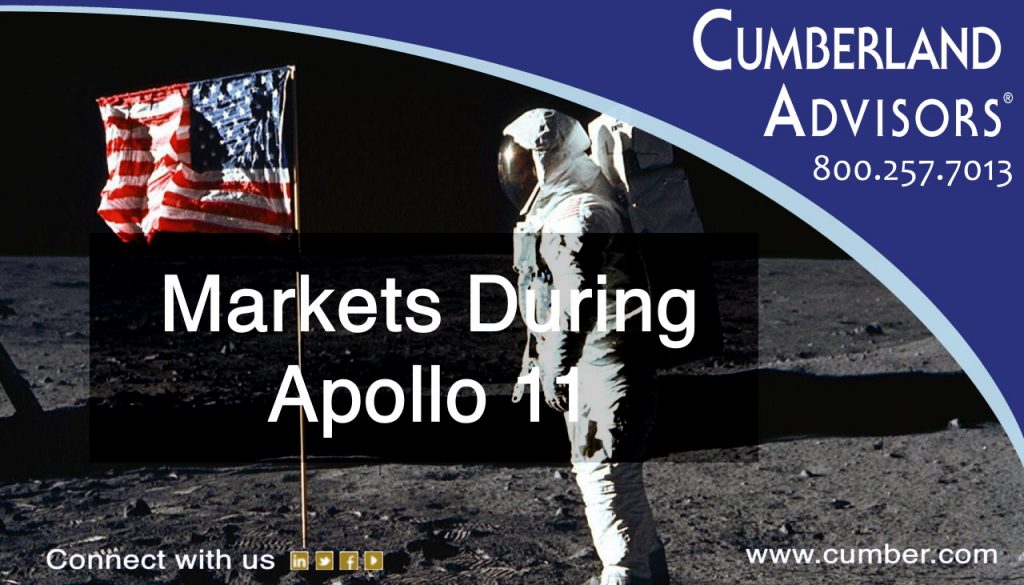This past week we celebrated the 50th anniversary of the Apollo 11 moon landing. Remarkably, only 1/3 of Americans today were alive when that happened.
As a 12-year-old kid I was riveted by the space program and tried to digest the minutia of every flight. Like a lot of kids, we watched the moon landing in the late afternoon in the East on Sunday July 20th, and then our folks woke us up to watch Neil Armstrong set foot on the moon six and a half hours later. It was a remarkable culmination of technological excellence and perseverance that fulfilled President Kennedy’s promise that we would land a man on the moon. And for all Baby Boomers, it was another moment where everyone remembers where they were.
The financial markets looked a lot different back in 1969.


Inflation Inflation in mid-1969 was running about 5.5%. It had been around 4.35% the year before in mid-1968 and about 2.75% the year before that. The Vietnam War was still escalating and adding to inflation numbers. Inflation would turn down to 2.7% by mid-1972 – in part due to partial price controls imposed by the federal government – but this was short-lived, and inflation reignited, fueled by the Arab-Israeli war of 1973, which produced the first oil shock; and the inflation that followed climbed to over 12% by 1974. After a brief respite where inflation fell under President Ford (remember “Whip Inflation Now,” WIN buttons?), it resumed its advance again in the late ’70s, peaking at almost 15% before starting the decline to today’s relatively mundane 1.6%

Equity MarketsThe Dow Jones was at 846 at the time of the moon landing. Amazingly, for all the good will the moon landing generated, the Dow declined almost 5% from the time of the landing till the end of the month (buy the rumor, sell the news?). The moon landing came in the middle of a slide from a peak in the Dow of 995 in early 1966 to a bottom of 631 in May 1970. That represented a loss of 36.6% from the high. To put that in perspective, it would represent a loss of almost 10,000 points in today’s Dow Jones average. Clearly the market was reacting to the problems in Vietnam, the Cold War, and inflation. The market would rebound to a height of 1051 (a rise of 66%) in January 1973 as GNP and industrial production picked up markedly. And then there was a long slide to 577 in December 1974 – a drop of 45% from the high less than two years before. This fall correlated with the unfolding of the Watergate crisis that took down the Nixon administration, along with war in the Middle East and a pick-up in inflation. It was quite a time to start an investment firm, but that’s what David Kotok and his partner Shep Goldberg did, in June 1973.

Bond MarketsThe ten-year Treasury bond was yielding 6.65% in 1969 and had been yielding 5.50% the year before. It was in an upward trend that would peak at year end at 8% before declining to 5.5% in the spring of 1971 and then beginning the long climb that would peak in 1981 at almost 16%. To put this in perspective, if you had bought a ten-year Treasury bond at par in the middle of 1968, a year before the moon launch, a year and half later it was worth 85 cents on the dollar. One of the benefits – nominally – back then was that the higher coupons would offset some of the price damage. The more important thing is that the rise in bond yields during this period represented only part of the secular rise in interest rates that had been in effect since the end of World War II and that would end in 1981. We have been in a secular decline in interest rates since 1981, with the current low of 1.3% being reached in 2016 in the period immediately after the Brexit election decision. Are we now seeing another secular rise in yields? We won’t know until we have gone through an entire interest-rate cycle.
It’s very clear that the equity markets have reflected the country’s growth in population and technology and our general development as a society. It’s been 20+ years since we have been at the level of bond yields that were existing at the time of the moon landing. Now, NASA talks about going back to the moon in 2024 and to Mars beyond that. It’s remarkable that it has taken us 50 years to revisit the moon. That’s not to argue the merits of spending money on the space program, but the spirit that the country displayed during that historic period would be terrific to recapture.
Links to other websites or electronic media controlled or offered by Third-Parties (non-affiliates of Cumberland Advisors) are provided only as a reference and courtesy to our users. Cumberland Advisors has no control over such websites, does not recommend or endorse any opinions, ideas, products, information, or content of such sites, and makes no warranties as to the accuracy, completeness, reliability or suitability of their content. Cumberland Advisors hereby disclaims liability for any information, materials, products or services posted or offered at any of the Third-Party websites. The Third-Party may have a privacy and/or security policy different from that of Cumberland Advisors. Therefore, please refer to the specific privacy and security policies of the Third-Party when accessing their websites.
Sign up for our FREE Cumberland Market Commentaries
Cumberland Advisors Market Commentaries offer insights and analysis on upcoming, important economic issues that potentially impact global financial markets. Our team shares their thinking on global economic developments, market news and other factors that often influence investment opportunities and strategies.


